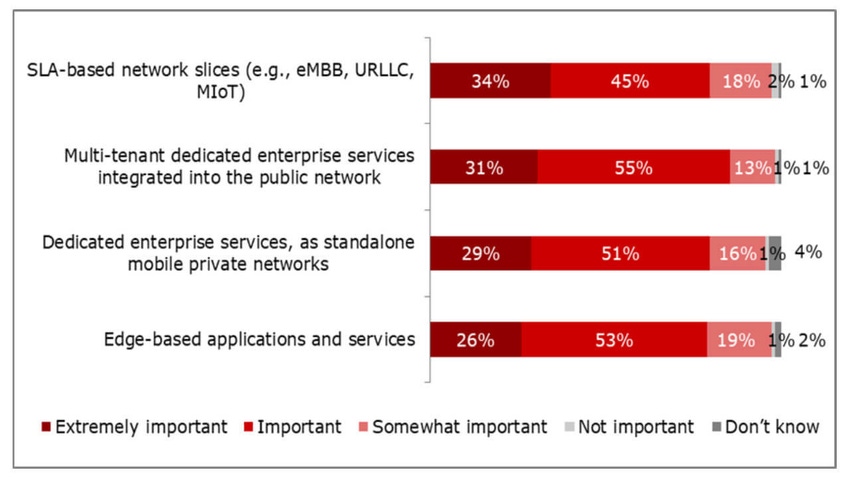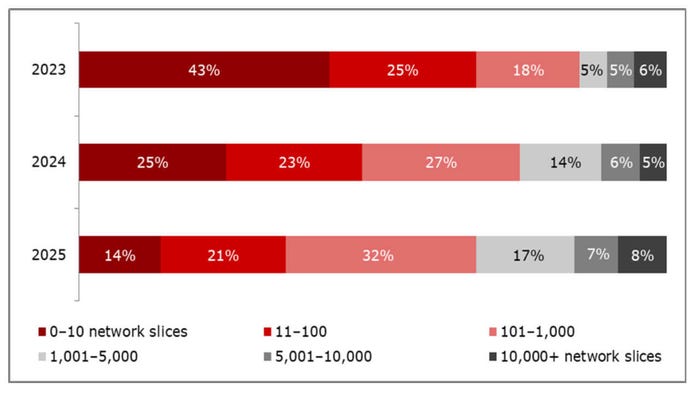5G orchestration: Services, standards and slices
Heavy Reading's 5G Orchestration and Service Assurance Market Leadership Program (MLP) survey results indicate that mobile service providers are taking important steps in their journey to monetize 5G services.

Many 5G service providers are entering the second phase of their 5G network deployment through the deployment of the standalone (SA) core network. Building upon the first phase, which introduced 5G spectrum and RAN, this second phase will allow service providers to deliver the low latency premium services that are crucial for recovering network investment. They must also execute strategies to ensure their networks can meet the additional orchestration requirements that 5G services will introduce.
To document and assess service provider orchestration and service assurance priorities, Heavy Reading launched the survey-driven 5G Orchestration and Service Assurance Market Leadership Program (MLP) with project partners Juniper Networks and RADCOM in March of this year.
This survey garnered 108 qualified mobile service provider responses from around the world, providing a global vista of the role that orchestration and service assurance will play in 5G service delivery and monetization. This first blog provides a summary of the key orchestration findings.
Orchestration service priorities
The 5G core implements new capabilities with the support of the RAN that will fuel the next wave of mobile service adoption. One foundational capability is the ability to expose APIs at the network edge, in private or even in a hybrid cloud configuration. Another is the ability to create software-based network slices for high value services.
These two functions are highly complementary and will enable service providers to support latency-sensitive services such as enhanced mobile broadband (eMBB), ultra-reliable low latency communications (URLLC) and multi-tenant services.
To meet or exceed the strict latency budgets of these premium offerings, service providers will have to develop new service-level agreements (SLAs) with their customers. In an orchestration context, 5G orchestrators must support the flexibility and programmability to meet these new demands.
As captured below, when asked to rank several 5G service options based on "extremely important" responses, SLA-based network slices led the way (34%). This result was followed closely by multi-tenant dedicated enterprise services integrated into the public network (31%), dedicated enterprise services as SA mobile private networks (29%) and edge-based applications and services (26%). Heavy Reading interprets this input as confirming that successful orchestration strategies must be multifaceted and able to support end-to-end orchestration to facilitate a comprehensive view of a service as it traverses the edge, RAN, core, transport network and even cloud domains.
How important are selling and orchestrating the following capabilities for monetizing 5G services?
Orchestration platform attributes
These flexibility demands will also affect the purchase criteria that service providers evaluate in making new orchestration platform purchasing decisions, as shown in the figure below.
Based on "extremely important" input, 37% of respondents selected open standards-based APIs as the leading purchasing decision. Close behind were other open attributes, such as the ability to integrate specialized third-party domain orchestrators (33%) and the ability to evolve existing current RAN, core and transport functions to open and standards-based APIs (29%).
Other functions, such as flexible resource management (30%), cloud native architecture (33%) and automated SLA management (33%), are also important. The message here is clear. To support end-to-end orchestration, 5G orchestrators must be open, cloud native and able to support automated processes, including automated SLAs.
How important are the following design attributes when purchasing a new orchestration platform?

(Source: Heavy Reading, 2023)
Slicing goes commercial
As noted above, service providers believe that selling and orchestrating SLA-based network slices represent the top priority to drive the monetization cycle. Still, as shown below, the rollout of slices will be gradual. This year, the largest group of respondents (43%) is forecast to deploy only 0–10 slices commercially. By 2025, 67% of these same respondents forecast they will still deploy 1,000 or fewer slices (14%: 0–10; 21%: 11–100; and 32%: 101–1,000).
How many commercial 5G network slices do you expect to deploy per year?

(Source: Heavy Reading, 2023)
To provide additional data granularity, all the survey results were filtered utilizing two groups: Tier 1 service providers (those with $1bn or greater in annual revenue) and Tier 2/3 service providers (those with less than $1bn in annual revenue). As anticipated, Tier 1 service providers plan to support a greater number of slices in the 5,000+ range over the next two years, culminating in 28% (16% + 12%) compared to 5% (0% + 5%) for Tier 2/3 service providers in 2025.
Tier 1 (n=51)

(Source: Heavy Reading, 2023)
Tier 2/3 (n=57)

(Source: Heavy Reading, 2023)
Important steps for service providers
Mobile service providers are taking important steps in their journey to monetize 5G services. This includes developing execution strategies required to monetize 5G services and roll out commercial slices. To support this generational shift, service providers are focusing on deploying orchestration platforms based on cloud native design principles that support open APIs, standards and automated processes.
Looking for more information?
Check out this archived Light Reading webinar: 5G Orchestration and Service Assurance Operator Survey: Priorities and Platforms
Access the white paper: 5G Orchestration and Service Assurance: A 2023 Heavy Reading Survey
This blog is sponsored by Juniper Networks.
About the Author(s)
You May Also Like




.jpg?width=300&auto=webp&quality=80&disable=upscale)







